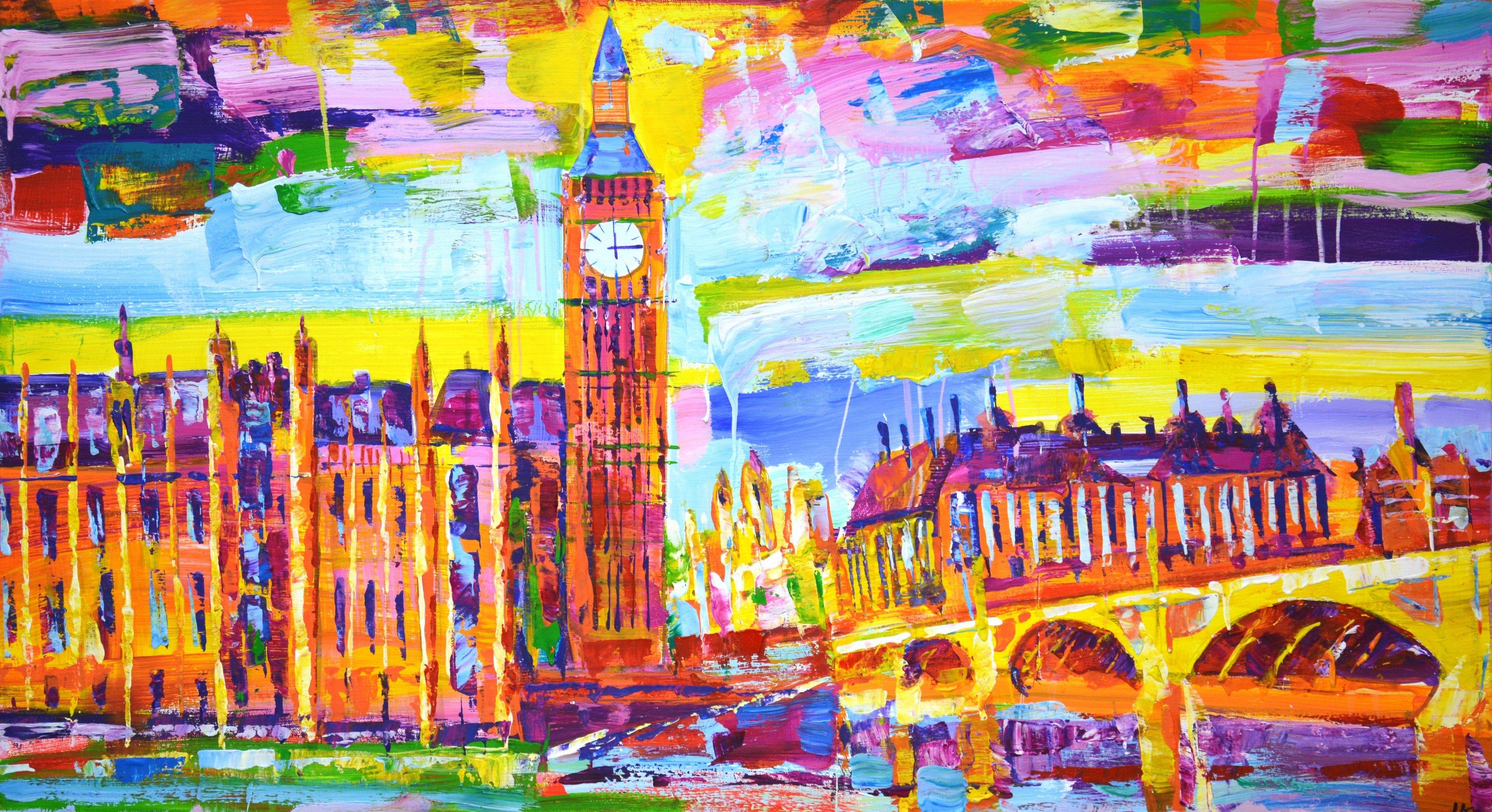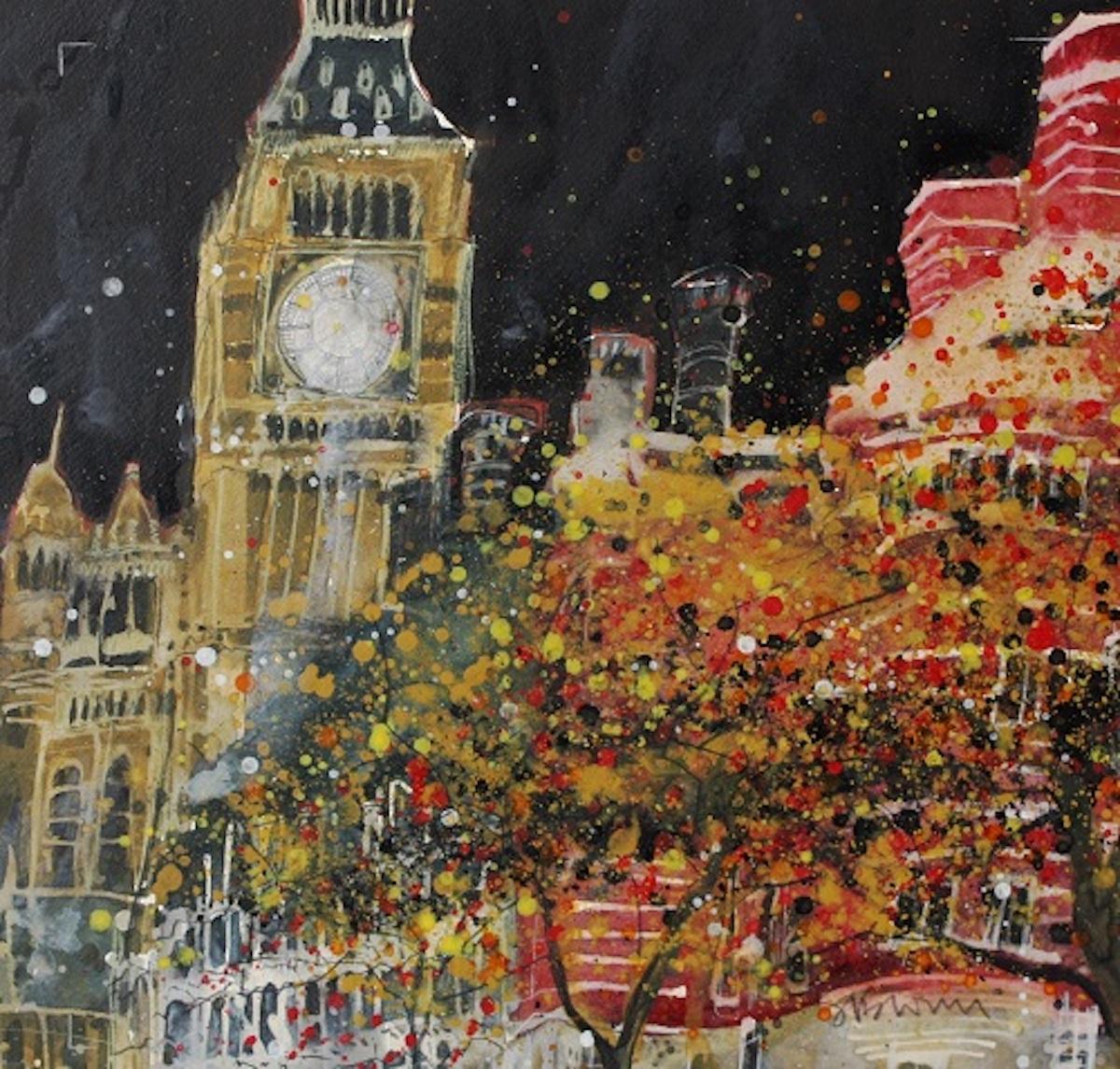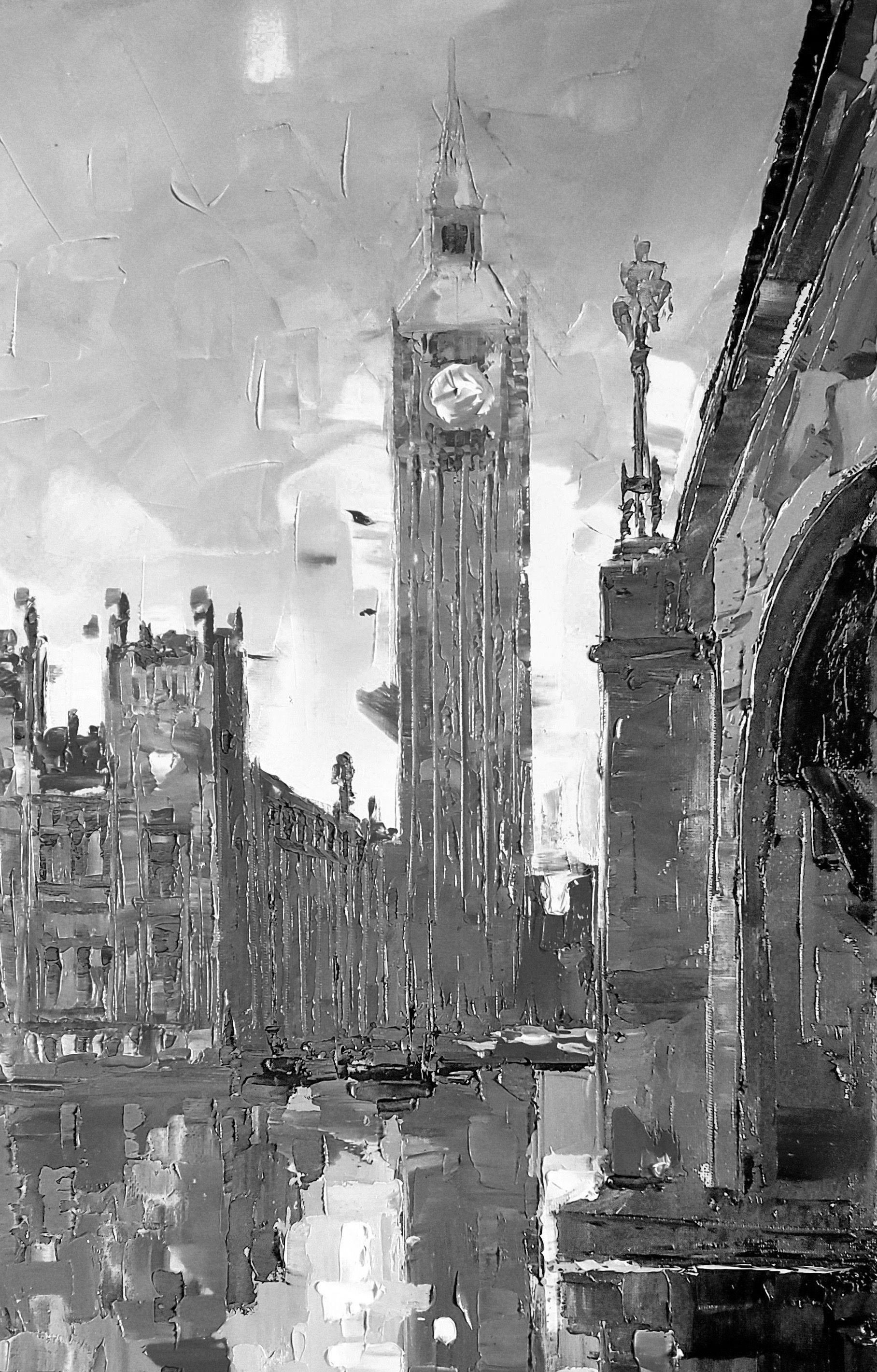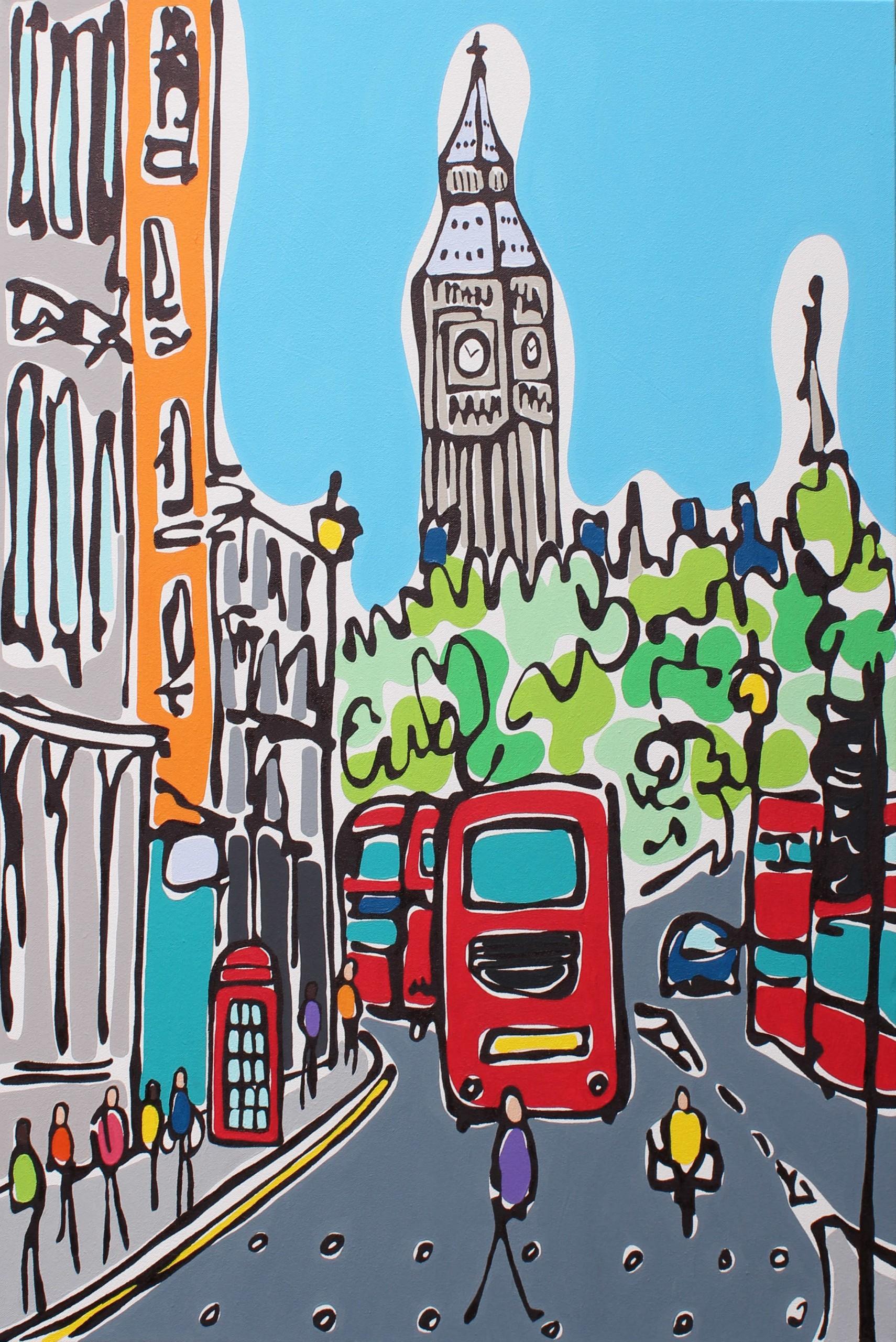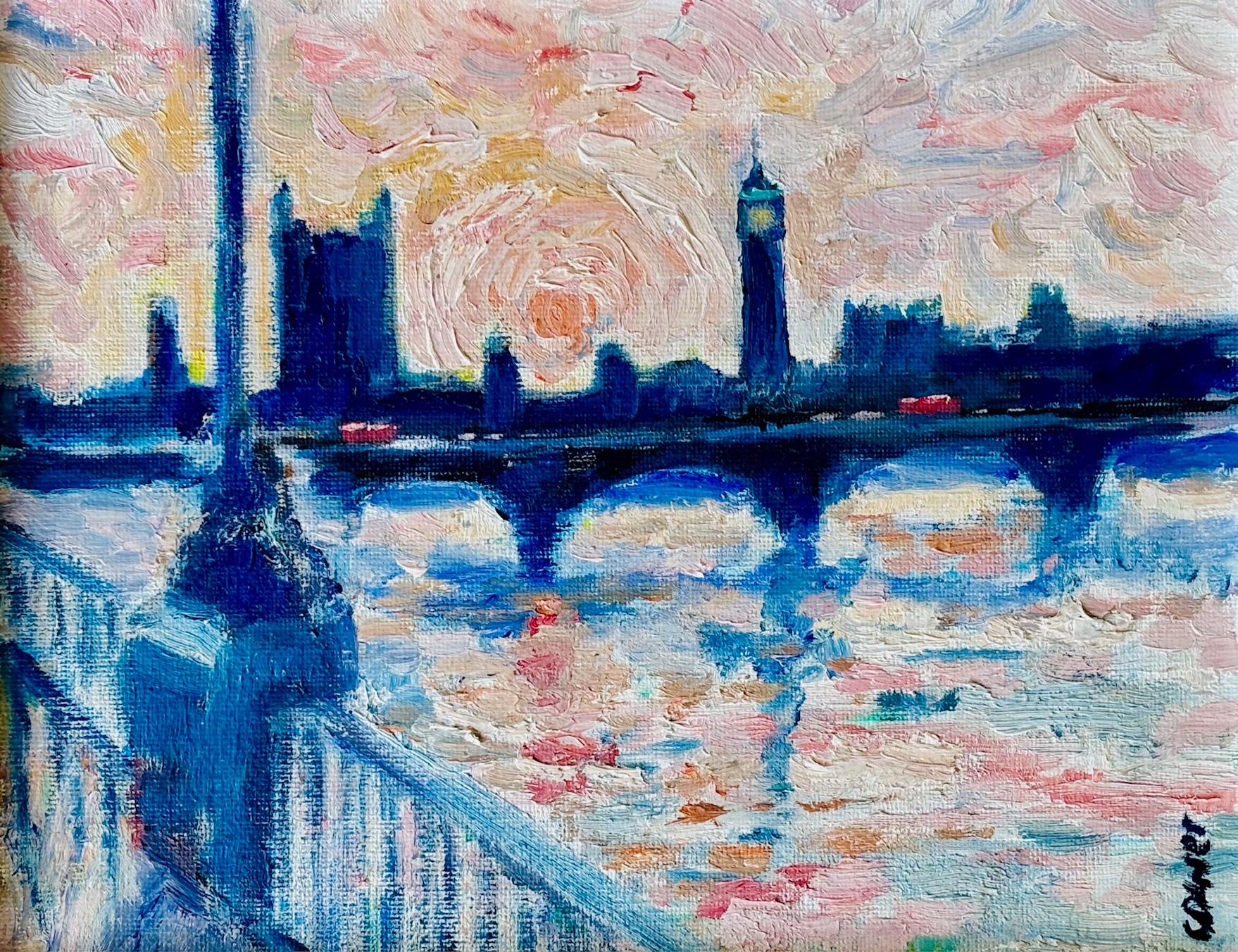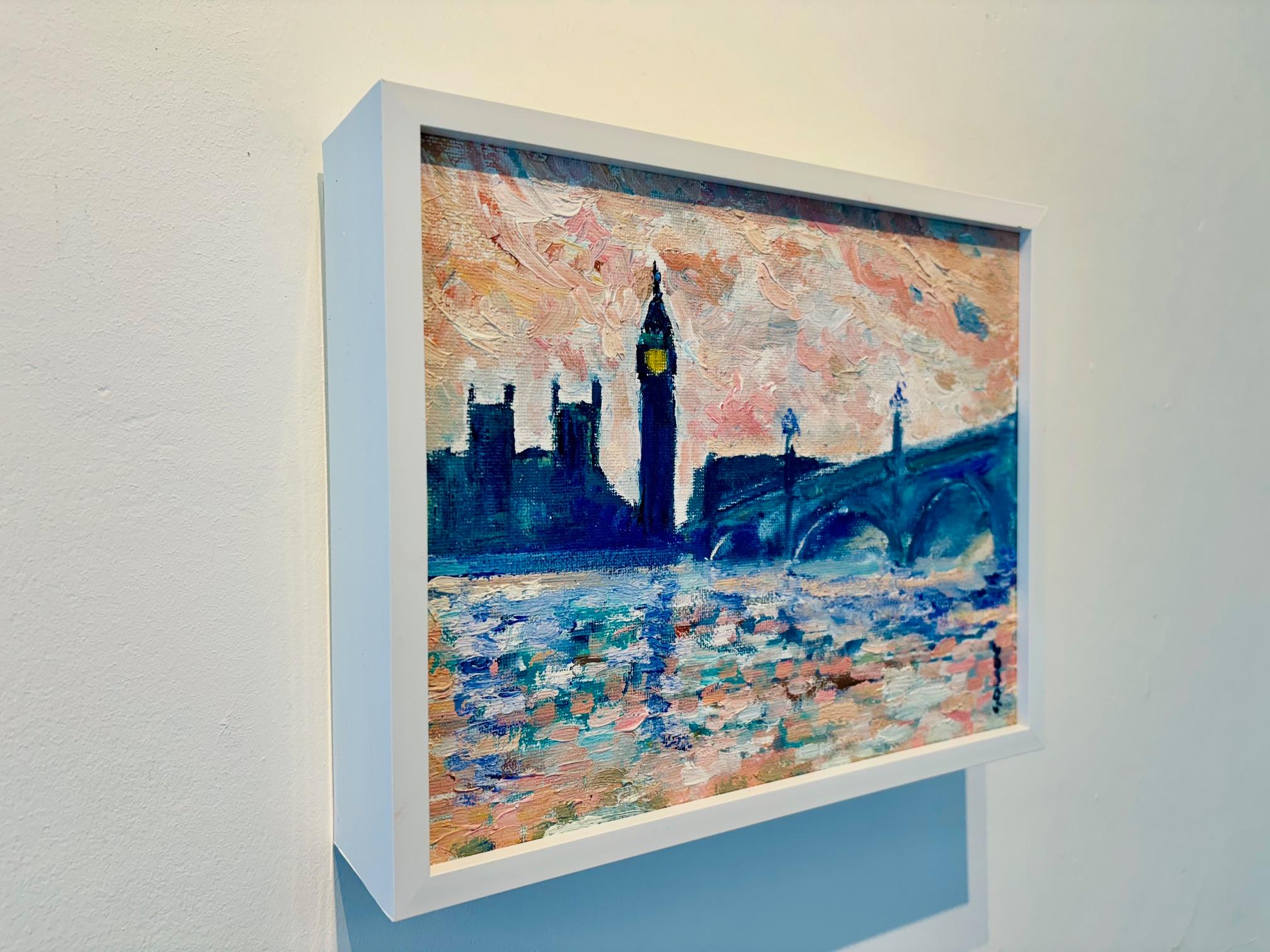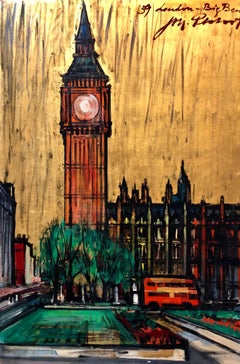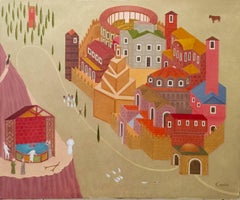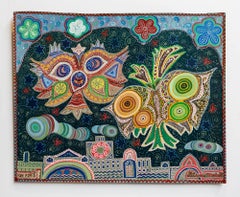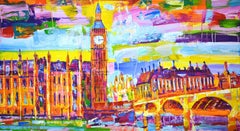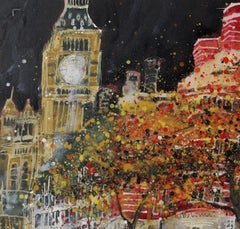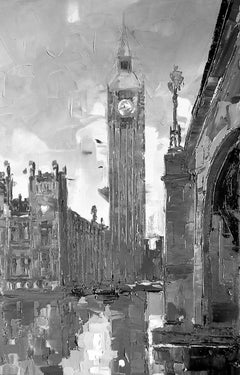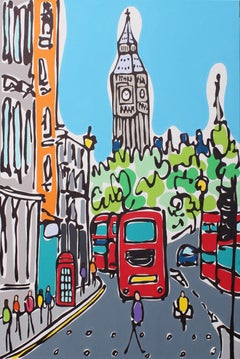Items Similar to Naive London Street Scene Folk Art Oil Painting Big Ben, Parliament, Union Jack
Want more images or videos?
Request additional images or videos from the seller
1 of 11
Andrew MurrayNaive London Street Scene Folk Art Oil Painting Big Ben, Parliament, Union Jack
$3,200
£2,429.39
€2,778.70
CA$4,470.86
A$4,972.58
CHF 2,596.53
MX$60,510.97
NOK 33,161.59
SEK 31,099.72
DKK 20,738.49
Shipping
Retrieving quote...The 1stDibs Promise:
Authenticity Guarantee,
Money-Back Guarantee,
24-Hour Cancellation
About the Item
Big Ben, House of Parliament with Union Jack flag, Thames River, boats, barges, airplane and double decker red bus. Classic London street scene.
24 inches by 11 inches in a frame 24.5 inches by 11.5 inches.
ANDREW MURRAY became known and loved as an imaginative Naive painter who captured the character of cities (especially Cape Town and London) with humorous and affectionate insight. An English counterpart to Michel Delacroix of Paris and Charles Fazzino of New York
He was born in north China, the son of a missionary. As a child of five he had his first lesson in painting from the son of another, the 10-year- old Mervyn Peake. Andrew's father, A.H. Jowett Murray, was the youngest son of Sir James Murray, the founding editor of the Oxford English Dictionary.
In 1956, in his 40th year, a chance present led to his breakthrough as an artist. An elderly English artist friend (perhaps by intuition?) gave Murray his own brushes and paints, and he bought himself Norman Colquhoun's Penguin Paint Your Own Pictures. So began the second and increasingly fruitful half of his life.
From the first, Murray's painting meant the release of the interior child which had been waiting for expression. A brief early dalliance with abstract painting taught him to think about structure in a way which became almost instinctive, but abstract forms could not satisfy the child's vision and sense of fun. Inevitably Murray is classified as a "naive" artist, but of a special kind: meditative, seeking the "inscape" of a scene; gently teasing in face of anything grand or pompous, yet without malice.
His subjects can be divided roughly into works of free imagination and evocation of city scenes. The former include biblical and religious subjects (but never too serious), animal and jungle groups, and playful variations on Jungian themes.
It was his Folksy city scenes, however, that gave Murray the success, first in Cape Town (1956-69) and thereafter in London and Paris, which enabled him and his wife to live by his painting. To their sorrow, they had no children of their own, but sales and commissions constantly led to lasting friendships which filled their successive homes with good conversation and laughter. Almost all Murray's pictures set in South Africa have remained there, some now in the National Gallery in Cape Town. In many, Table Mountain rises above the scene, an icon as dominant as Mount Fuji in Japanese painting. The images of street life have a vividness and humour which is rarely if ever surpassed in Murray's later pictures set in London or other European cities.
Murray was taken on by the Portal Gallery (then in Grafton Street) and began a series of successful exhibitions, especially "Poetry into Paintings" and the two series of "Images of Reconciliation"; one of these "images", the lion cradling a lamb, was adopted as a Unicef Christmas card.
Perhaps it was partly the success of this card which suggested a series of gift cards reproducing paintings in colour; once the Murrays had settled (in Chelsea), the cards could give their address, and sales and commissions could be arranged without depending on a gallery. Murray also learned colour etching and for a few years produced a number of successful works, but always concentrated on painting and producing the "Andrew Murray Cards". In the next 20 years the series of these grew to well over a hundred, and in 1980 a selection was reproduced as a book, Andrew Murray's London.
At first the cards (and etchings) included some works of free imagination, but it was the London scenes - both major public monuments and attractive corners, especially of Chelsea - which sold best. Andrew did the paintings and oversaw the colour printing; then Beryl found sales outlets and kept them supplied. People recognised and enjoyed the characteristic clouds like piled puffballs, the ridiculously huge flags and the horses with bulgy Chippendale table legs, pulling drays or carrying policemen, but also, deeper than the fun, the intimate feel for London's moods and a sure sense of structure and colour harmony.
Commissions came from many sides; a set of four Christmas cards, very popular for several years, led to Sheikh Yamani's commissioning a Koranic Nativity to send to his Christian friends. Eventually the most fruitful outlet came to be London Mitsukoshi; they both bought and sold many of Murray's paintings and agreed to his producing cards from the same, while in Tokyo small reproductions on phone cards became fashionable.
In later years the task of distribution became too heavy and the Murrays sold Andrew Murray Cards to Simon Tan, a Singapore Chinese resident in London, who (with his own family) became a close friend and support. One of his developments which has continued is Harrod's annual calendar of Murray's London scenes.
- Creator:Andrew Murray (1917 - 1998)
- Dimensions:Height: 24.5 in (62.23 cm)Width: 11.5 in (29.21 cm)
- Medium:
- Movement & Style:
- Period:
- Condition:frame has wear. minor waviness to canvass. light wear. please see photos.
- Gallery Location:Surfside, FL
- Reference Number:1stDibs: LU38215556922
About the Seller
4.9
Platinum Seller
Premium sellers with a 4.7+ rating and 24-hour response times
Established in 1995
1stDibs seller since 2014
1,784 sales on 1stDibs
Typical response time: <1 hour
- ShippingRetrieving quote...Shipping from: Surfside, FL
- Return Policy
Authenticity Guarantee
In the unlikely event there’s an issue with an item’s authenticity, contact us within 1 year for a full refund. DetailsMoney-Back Guarantee
If your item is not as described, is damaged in transit, or does not arrive, contact us within 7 days for a full refund. Details24-Hour Cancellation
You have a 24-hour grace period in which to reconsider your purchase, with no questions asked.Vetted Professional Sellers
Our world-class sellers must adhere to strict standards for service and quality, maintaining the integrity of our listings.Price-Match Guarantee
If you find that a seller listed the same item for a lower price elsewhere, we’ll match it.Trusted Global Delivery
Our best-in-class carrier network provides specialized shipping options worldwide, including custom delivery.More From This Seller
View AllLondon, Big Ben Cityscape Mid Century Architectural Modernist Gold Leaf
By Josef Marc Plotast
Located in Surfside, FL
Plotast, Josef Marc (Joseph Mark)
Was born in Southbridge, Massachusetts, on August 8, 1917, studied architecture and art at various universities and art schools in France, Italy, Po...
Category
1950s Modern Landscape Paintings
Materials
Oil, Board
Street Art Outsider Art Painting Abstract Cityscape with Dogs
Located in Surfside, FL
Done in a manner reminiscent of Keith Haring and LA Ortiz.
Category
Late 20th Century Street Art Abstract Paintings
Materials
Acrylic
Fantastic Village Scene Modern Irish Magic Realism Oil Painting
By Philip Castle
Located in Surfside, FL
Philip Castle was an Irish Painter and husband to artist Barry Castle
He is rarely exhibited. His detailed, meticulous work took a long time to complete and his output was quite li...
Category
20th Century Folk Art Landscape Paintings
Materials
Canvas, Oil
Israeli Folk Art Bright Colorful Naive Jerusalem Vibrant Landscape Painting
By Menia Litvak
Located in Surfside, FL
My life as an artist started in 1976 when I left Kishinev (Bessarabia) for Israel. In my youth I did not have the opportunity to study an regularly, although I learned painting during some two years at the Belle-Arts Academy in Kishinev and one year in Bucarest. My youth was spent during world war 2 when Bessarabia was annexed by the Soviet Union, years of hunger and the need to work very hard to be able to survive. I worked as a retoucher of photographs in a studio. When I arrived in Israeli went to live in Jerusalem and took up painting as my only ocupation, not as in Russia where it was one of my occupations which I had to do sometimes in hiding, stealong time from my everyday jobs. Israel, its colourings, impressed me much: the blue of the sky, the turquoise of the sea, the palette of desert colours. The stones of Israel looked alive and I wished I could paint them all. In 19761 started to expose my work. Since then I participated in a number of exhibitions in groups and alone. Since 1984 I am a member of the Israeli Union of Painters and Sculptors. The last exhibition where I took part was at the Salon des Beaux-Arts in Paris together in a group of Jerusalem artists. Israel has had a Vibrant Folk Art, Naive art scene for a long time now artists like Yisrael Paldi, Nahum Guttman...
Category
20th Century Folk Art Figurative Paintings
Materials
Gouache
Large Israeli Naive Art Screen Enamel Oil Painting Jerusalem Old City Folk Art
By Gabriel Cohen
Located in Surfside, FL
JERUSALEM, Vielle du David, (City of David) Superlac (enamel) painting on paper, hand signed, titled and dated.
Provenance: Michael Hittleman Gallery Los Angeles.
Gabriel Cohen, (...
Category
20th Century Folk Art Landscape Paintings
Materials
Paper, Oil, Alkyd
Whimsical French Folk Art, Naive, Oil Painting Madeline Marie Christine Clavier
By Madeline Christine Clavier
Located in Surfside, FL
MADELINE CHRISTINE CLAVIER (1913-2015)
Signature: Signed lower right & titled verso
Medium: Oil on canvas
Provenance: The collection of the artist's family
Marie Christine Clavier was born in Saigon, Vietnam in 1913 to French parents and lived there for her formative years. She returned to France as a teenager and began to study painting. Her work quickly developed into whimsical paintings of poetry and songs – harmonized in a unique and distinct painting technique. Her work has an impasto feel and a folk art, outsider artist sensibility to it. Similar in style to Maik and other fantasy realists who use animals, flowers and foliage in their artworks. Marie Clavier painted ro herself rather than for profit as she was quite independently wealthy. She exhibited extensively in the United States in the 1970s especially across Connecticut and New York, showing at various galleries and cultural centres. She had numerous solo exhibitions in the 1970’s- notably at the Maison Francaise in New York and New York University. She showed at Galerie Bernheim Jeune in Paris. She won many awards for her work including Gold Medals and Palme D’Or medals. In 1988 the prestigious art publisher Leopard D’Or produced catalogue book on her life and work – by this point she had virtually given up painting. She died in 2015 aged 102.
Bernheim-Jeune gallery is one of the oldest art galleries in Paris. Opened on Rue Laffitte in 1863 by Alexandre Bernheim (1839-1915), friend of Delacroix, Corot and Courbet, it changed location a few times before settling on Avenue Matignon. The gallery promoted realists, Barbizon school paintings and, in 1874, the first impressionist and later post-impressionist painters. It closed in 2019. In 1901, Alexandre Bernheim, with his sons, Josse (1870-1941), and Gaston (1870-1953), organized the first important exhibition of Vincent van Gogh paintings in Paris with the help of art critic Julien Leclercq. In 1906, Bernheim-Jeune frères started presenting works by Pierre Bonnard, Edouard Vuillard, Paul Cezanne, Henri-Edmond Cross, Kees van Dongen, Henri Matisse, Le Douanier Rousseau, Raoul Dufy, Maurice de Vlaminck, Amedeo Modigliani, Maurice Utrillo and Georges Dufrenoy. From 1906 to 1925, art critic Félix Fénéon was the director of the gallery and was instrumental in bringing in the art of Georges Seurat and Umberto Boccioni.
In 1922, an exhibition brought together works by Alice Halicka...
Category
20th Century Folk Art Animal Paintings
Materials
Canvas, Oil
You May Also Like
Favorite London., Painting, Acrylic on Canvas
By Iryna Kastsova
Located in Yardley, PA
Favorite London. Pop Art. This unique expressive picture is painted with acrylic paints. Can become an accent of your interior. The product has a mature modern aesthetic design and ...
Category
2010s Expressionist Paintings
Materials
Acrylic
Cities 10 - Norman Shaw Buildings, Big Ben, London by Susan Brown
Located in Deddington, GB
Cities 10 – Norman Shaw Buildings, Big Ben, London by Susan Brown.
Limited Edition and hand signed by the artist
It’s Autumn, cold and crisp, and walking...
Category
21st Century and Contemporary Contemporary Figurative Prints
Materials
Giclée, Paper
LONDON. BIG BEN., Painting, Oil on Canvas
Located in Yardley, PA
LONDON. BIG BEN. :: Painting :: Contemporary :: This piece comes with an official certificate of authenticity signed by the artist :: Ready to Hang: Yes :: Signed: Yes :: Signature L...
Category
2010s Contemporary Paintings
Materials
Oil
London Summer by Rachel Tighe, Westminster, Original Painting, Acrylic on canvas
Located in Deddington, GB
A painting of a walk from Trafalgar Square to Westminster in the hustle and bustle of London.
Additional information:
London Summer by Rachel Tighe [2022...
Category
2010s Contemporary Landscape Paintings
Materials
Cotton Canvas, Acrylic
Big Ben from Southbank - original impressionism cityscape - contemporary Art
Located in London, Chelsea
This exceptional artwork is currently on display and available for sale at Signet Contemporary Art Gallery and online.
In "A View of Big Ben," Richard Gower delivers a captivating p...
Category
21st Century and Contemporary Impressionist Landscape Paintings
Materials
Canvas, Oil
A View of Big Ben - original impressionism cityscape - contemporary Art
Located in London, Chelsea
This exceptional artwork is currently on display and available for sale at Signet Contemporary Art Gallery and online.
In "A View of Big Ben," Richard Gower delivers a captivating p...
Category
21st Century and Contemporary Impressionist Landscape Paintings
Materials
Canvas, Oil
More Ways To Browse
Vintage Leg Art
Japanese Street Art
Early Christian Art
Houses Of Parliament
Vintage Lion Painting
Vintage Chinese Oil Painting
Christian Religious Art
James Childs Painting
Union Flag
Big Ben
20th Century Oil Paintings China
Vintage Jungle Art
Vintage Airplane Art
Union Jack
English River Scene Painting
Japanese Christian
Folk Art Lion
Lamb Oil Painting
